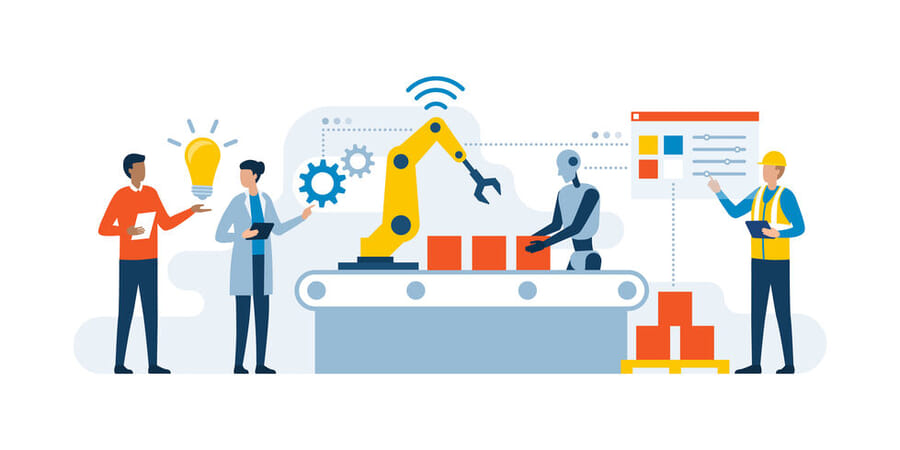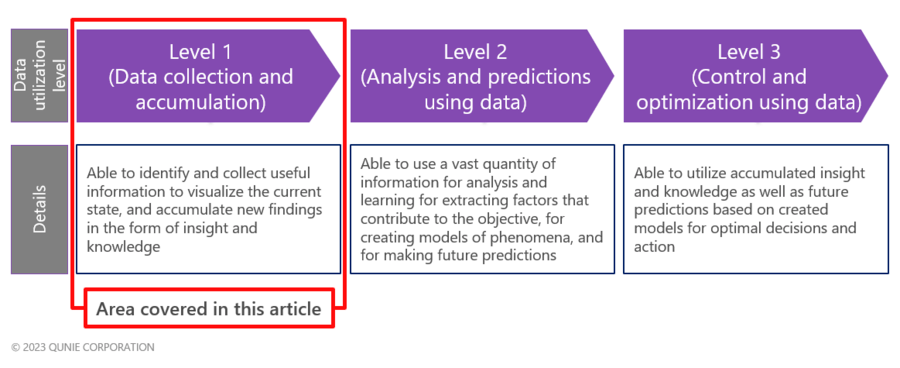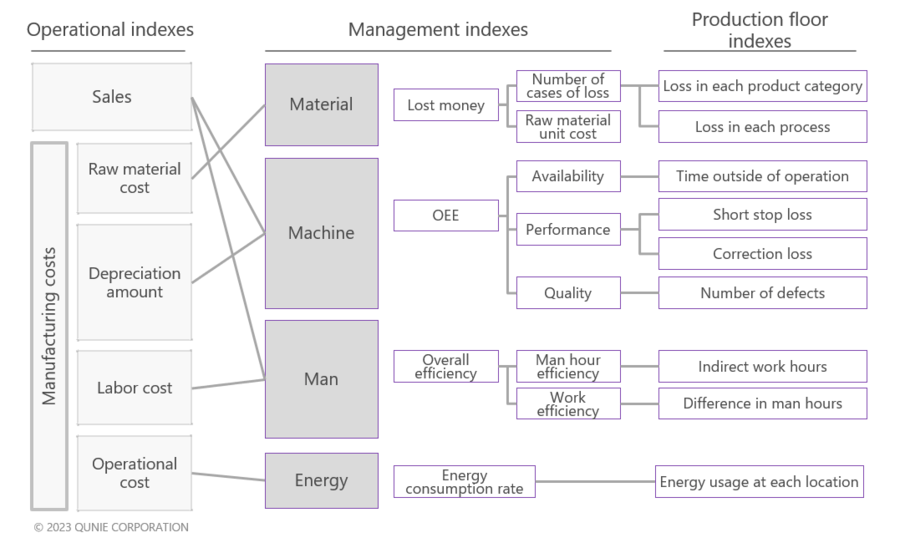Sep 21, 2021
Tips for consumer goods companies towards successful smart factories
Challenges and solutions for struggling Japanese companies
Satoru Takahashi

Summary
- With the rapidly changing business environment for consumer goods companies in recent years, it is important to engage in smart factory initiatives as a method for a flexible response to external changes while boosting productivity.
- Despite the increasing needs for smart factories, Japanese consumer goods companies are falling behind. One possible factor for the lag is the complicated calculation of Return on Investment (ROI) for such initiatives, hindering sound investment decision-making.
- There are three key factors to boost ROI and attain success: (1) Starting off with creating a story to describe how smart factory efforts will drive a contribution to business management; (2) Designing KPIs that are comparable and automatically monitorable among manufacturing processes and/or factories while simultaneously contributing to business management all together; and (3) Organizing and visualizing production operations, and digitalizing information with a sharp focus on effectiveness.
Demand for smart factories
Recently, Japanese consumer goods companies are facing an increasingly dynamic business environment where companies need to flexibly respond to changes in the external environment. This is especially true for production floors to function as the companies' manufacturing hub. As consumer demand for product diversity requires high-mix low-volume production while social awareness for food safety continues to rise, many companies may be expected to obtain and maintain international standards including ISO 22000 Certification [1] and FSSC 22000 Certification [2], or Halal Certification [3] to enter overseas markets.
Meanwhile, the demand for higher productivity seems to continue at the company level, adding many challenges for companies to face in the manufacturing field. For example, I have seen a case where a company wanted to use data to analyze factors and bottlenecks for a decrease in equipment utilization rate but delayed in taking actions because it took too long to gather the necessary data when needed. In another case, a company wanted to renew its equipment before it broke down but delayed in taking actions because there was no clear basis or data necessary for investment decision-making. These cases show challenges where companies failed to carry out their improvement cycle due to the lack of data or took too much time to collect these figures.
One possible method to accommodate both "flexible responses to external changes" and "higher productivity within a company" is to deploy IoT, AI, and other forms of ICT to engage in smart factory initiatives that will boost productivity and optimization of factories based on data. In this article, a smart factory is defined as "a facility that collects data related to each element (people, products, money, and information) necessary to determine its productivity; and analyzes and utilizes the data to carry out a productivity improvement cycle and make advanced strategic decision-making with a data-driven approach to be capable of benefiting business operations through cost reduction and cash flow improvement (such as investment control and inventory reduction).
Challenges in the transformation to a smart factory
Next, let’s look at the challenges for companies to launch smart factory initiatives. Upon the rise of Industry 4.0 in Germany, attention to smart factories has grown worldwide, and the number of inquiries and projects relating to s has been increasing in recent years. At the same time, quite a few clients say "calculating Return on Investment (ROI) of smart factory initiatives is too complicated to reach sound investment decision-making," which prevents them from pushing on with the initiatives. For example, one common request is to visualize equipment utilization status with the help of IoT technology. In many cases, even though the companies are capable of specifying visualization requirements including the details of production-line progress and a factor analysis of equipment breakdown, they come short of accurately collecting and analyzing data, or making predictions using data as a next step, let alone leveraging these initiatives to make substantial contributions to business management such as capital investment control, reductions in work-in-process inventories and costs, or a yield improvement.
In this article, drawing on my expertise in the area of smart factory transformation in food and consumer goods companies, I will focus on "Level 1: Data collection and accumulation" out of three basic steps for smart initiatives published by the Ministry of Economy, Trade and Industry [4] as follows: "Level 1: Data collection and accumulation," "Level 2: Analysis and predictions using data," and "Level 3: Control and optimization using data." The conclusion provides an overview of the key points to achieve smart factory transformation to achieve an increased ROI.

Fig 1: The three basic steps for smart initiatives
Source: Created by QUNIE based on Ministry of Economy, Trade and Industry "Roadmap Survey on Smart initiatives in Monodzukuri" (in Japanese).
Tips towards a successful smart factory transformation
Here is a summary of three tips to successful smart factory initiatives: two from a perspective of boosting effectiveness, and one from that of reducing costs.
(1) Creating a story of smart factory transformation that brings contribution to business management
The first tip to increase the effectiveness of smart factory initiatives is "creating a story that will contribute to business management." To avoid failure of implementing a smart factory in vain, first of all, it is crucial to set clear business outcomes (objectives) to be achieved, and refine a story to articulate how these initiatives will benefit business management. For example, imagine a case where a company wants to introduce an IoT-driven management system for manufacturing that would raise the visibility of operations in order to increase profits. The IoT technology will make it possible to collect and accumulate the details of error messages including the exact time when equipment breakdowns (or brief pauses in production) and speed drops occurred, which used to be difficult to obtain. These data will help businesses determine the causes of productivity drops and the real bottleneck process, and ultimately enhance equipment utilization or even achieve a reduction in manufacturing cost to drive profit improvement. Creating such a story is a key for a successful smart factory project.
(2) Designing monitorable KPIs that cover everything from production floors to executives
The second tip to generate greater effects is to "design monitorable KPIs that cover all areas from production floors up to the C-suite." After clarifying a story aimed at achieving business outcomes (objectives) and contributions to business management all together, the key point is to design automatically monitorable KPIs that can meet the objectives and be comparable between processes and factories. The KPIs should be designed by linking all indexes ranging from data and indexes at production floors (the defect rate, facility stop time, and other indexes monitored on-site) through management indexes to business operation indexes. Furthermore, it will become possible to compare KPIs between factories only after setting data definitions to measure the KPIs, such as the specific start and end time for running equipment. Let’s say a company has continuous production lines in multiple factories. One factory defines the operation end time as the end time of the upstream production process while another factory defines the same term as the end time of the downstream production process. If the definition of the same term "operation end time" differs by factories like this, it means nothing to make comparisons across factories. To avoid such a situation, it is important to set data definitions and design KPIs that will link all areas from production floors to corporate management. By utilizing IoT technology to monitor the KPIs, companies can instantly generate and display the real-time data directly from production floor equipment, and deliver real-time decision-making.
Fig. 2 takes an example where profit improvement is the objective of implementing a smart factory. To achieve this objective, KPIs and production floor indexes have been designed based on 3M+E (an acronym for Man, Machine, Material, and Energy; the crucial factors related to quality control and process management in the manufacturing business). By instantly obtaining and displaying the short stop time and other types of data from manufacturing floors, it will become possible to monitor real-time management and operational indexes, allowing faster action taken against factors that could impact business performance. Furthermore, at the stage of designing KPIs, a company should clarify where responsibility lies when KPIs go wrong (such as making manufacturing floors responsible for monitoring and improving equipment utilization). In so doing, it becomes possible to solidly engage in the PDCA cycle and make contributions to business management.

Fig. 2: Example of KPI design
(3) Clarifying the requirements and priorities for data collection and accumulation
The third tip is a key for reducing costs towards transformation to a smart factory: to clarify requirements and priorities for data collection and accumulation.
To cut software costs, it is vital to identify which parts of the manufacturing operation process to deploy ICT technology in order to enhance the effectiveness. It is crucial to start by organizing and visualizing the ongoing production operations and clarifying the challenges before designing a manufacturing operation model. However, there seems to be many cases where companies that could organize operation processes, clarify challenges, and propose measures still end up with additional man-hours for system design and development in addition to higher costs as they fail to clarify priorities for the system requirements or identify more effective areas based on their manufacturing operation model. In order to avoid such a situation, companies should decide the priority of system requirements based on their manufacturing and production-line characteristics, and take into account not only requirements for business process improvement but also quality control requirements such as FSSC 22000, traceability requirements, and visualization requirements along with other manufacturing-related requirements. Only truly necessary information should be extracted and digitized. These steps will lead to satisfactory results while maintaining the minimum level of digital investments. In addition, designing the ideal manufacturing model beforehand makes it easier to standardize operations across manufacturing processes and factories, helping reduce initial costs to scale out the smart factory initiatives.
For example, though food manufacturing companies store many types of data for the purpose of quality control, not all the items but only CCPs (Critical Control Points) and OPRPs (Operational Prerequisite Programs) in HACCP [5] may need to be digitalized. It is important to determine what information is truly necessary for each purpose of data acquisition to be under control between manufacturing processes and factories.
Meanwhile, to curb hardware costs, the key point is to not only identify the truly essential data, but also to focus on the frequency of data acquisition. For example, a company could design the system to conduct data acquisition once a day for product categories, and once every second for equipment failures. Designing the optimal acquisition frequency for each type of data can help reduce hardware costs such as server costs.
Conclusion
This article presents tips to increase your ROI regarding "Level 1: Data collection and accumulation" out of the basic steps indicated by the Ministry of Economy, Trade and Industry towards smart factory transformation.
Establishing a foundation in "Level 1: Data collection and accumulation" is a crucial step to further increase productivity in the following steps of "Level 2: Analysis and predictions using data" and "Level 3: Control and optimization using data." In the case of the food manufacturing business, for example, if companies succeed in collecting and accumulating changeover time (the time required when products or processes must be swapped) for each product type and container type, it will be possible to develop the optimal production sequence that meets the supply and demand plans and to minimize the loss caused by changeover time in the future. Once they can gather and store data on manufacturing parameters and manufacturing environment information, it will be possible to allow machines to automatically control manufacturing conditions based on the environment of each day, leading up to full automation. All of these can be achieved only after establishing a foundation for data collection. When promoting smart factory initiatives, it is important to draw a roadmap in advance, not only for the initial step of "Level 1: Data collection and accumulation," but for the subsequent steps of "Level 2: Analysis and predictions using data" and "Level 3: Control and optimization using data," while organizing the impact on business management step by step. It is also important to steadily implement and promote reforms in accordance with the roadmap.
The road to smart factories is a long one, and few companies around the world have reached Level 3 yet. However, steady efforts to move up the steps can bring a major difference over companies that have not yet implemented smart factories, and can help nurture the strengths to respond to a rapidly changing external environment. I hope this article can help Japanese consumer goods companies and other players in the manufacturing business succeed in smart factory transformation.
- [1] ISO 22000: An international standard for food safety management systems. This standard helps mitigate food safety risks based on the food sanitation management methods in HACCP, and it helps realize the development of safe food supply chains.
- [2] FSSC 22000: An international standard for food safety management systems that reinforces ISO 22000 with additional requirements. This standard has been recognized by the Global Food Safety Initiative (GFSI) as a set of benchmarking requirements.
- [3] Halal Certification: A halal-certified organization inspects products and services and certifies to check that they are produced or provided in accordance with Islam, and the organization grants Halal certification if the products and services in question fulfill specific criteria.
- [4] Ministry of Economy, Trade and Industry (2017), "Roadmap Survey on Smart initiatives in Monodzukuri," https://www.meti.go.jp/meti_lib/report/H28FY/000093.pdf (retrieved on September 21, 2021) * Japanese
- [5] HACCP: Hazard Analysis and Critical Control Point. HACCP represents a method for businesses in food and other areas to understand hazards such as contamination with food-poisoning bacteria or other foreign matter; to control the most important processes that can eliminate or mitigate these hazards out of all the processes from receiving raw material deliveries to shipping finished products; and to thereby carry out hygiene control to ensure product safety.






